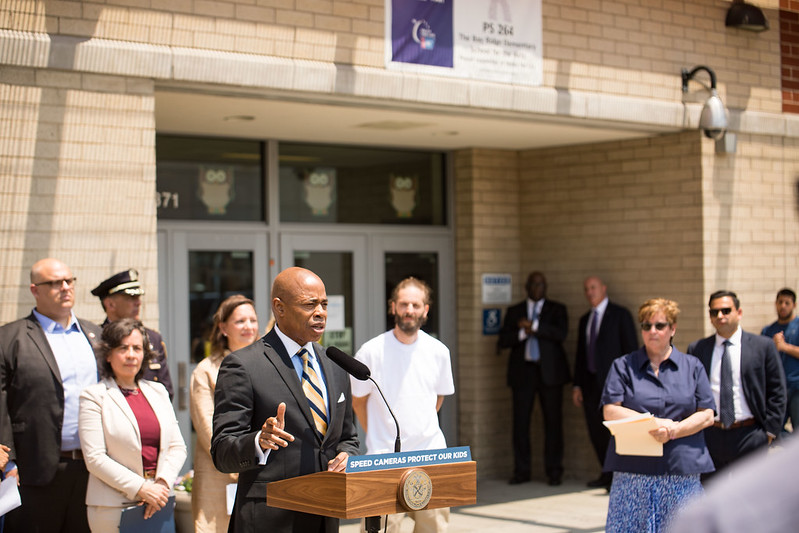Governor, Legislature Must Take CUNY Cuts Off The Table

City College graduation of the past (photo: CUNY)
We cannot have a meaningful conversation about educational equity in New York City without calling attention to the deep funding cuts that the City University of New York (CUNY) is facing. For countless New Yorkers like myself, CUNY means access to an excellent public education and a path to career. Cutting CUNY resources flies in the face of the discussions we are having right now around racism, classism, and social justice.
Governor Andrew Cuomo and the State Legislature are weighing steep cuts to CUNY’s budget, and we need to be clear about exactly what those cuts would mean: reducing the quality of a public higher education system in New York that mainly serves historically-marginalized communities of color; 25% of CUNY undergraduate students identify as Black, 30% identify as Latino, and 60% receive Pell grant funding. Any discussion must meet the moment and be about what lawmakers can do to lift up institutions that serve all New Yorkers, particularly those that have educated thousands of young people of color for generations.
I know why CUNY means equity because I’ve lived it; I’m one of over 200,000 students of color who attend CUNY schools every year.
CUNY is led by Félix Matos Rodríguez, a champion for New York City college students and equity in education. He is well-known in the higher education community for his commitment to breaking down financial barriers for students from low-income backgrounds, as well as his appointments of senior leaders of color at CUNY. Under his leadership, many Black, Latino, and first-generation students have received life-changing educational opportunities and launching pads to careers of their choosing.
I personally wouldn’t have been able to graduate debt-free this spring if not for CUNY. My sister – who was the first in my family to go to college – went to City College and had an amazing experience, so I applied and received a scholarship. I was in good company at KIPP NYC College Prep High School in the Bronx, which sent 76 students to CUNY schools the year I graduated. In fact, since our high school started graduating students seven years ago, 40% of its student body has gone to CUNY.
At City College, I was a part of the media and communications program. Within my program, I learned the ins and outs of the advertising and public relations industry while also connecting and building relationships with my professors, who are professionals in the field. Through my program, I was able to find internships and stay on track with my career goals.
By cutting funds, CUNY students will not be afforded the opportunities I was given. During my time at City College, I was granted access to resources like the writing center, the career center, and amazing adjunct professors, who helped me navigate course and career decisions. Many CUNY students are first-generation college attendees; taking away these vital resources would stunt the trajectory from college to career, and beyond.
Cutting CUNY’s budget would hinder schools and the diverse student population they serve, plain and simple. I’m asking the governor and the Legislature to do the right thing and preserve funding for CUNY. Let’s move one step closer to creating the equitable New York we all deserve.
***
Miranda Genao graduated from The City College of New York in May 2020 with a degree in Media and Communications. She is a first-generation college student from the Bronx.
***
Have an op-ed idea or submission for Gotham Gazette? Email This email address is being protected from spambots. You need JavaScript enabled to view it.
Covid Laid Bare Systemic Disparities. Our City Must Make Bold Changes for an Equitable Recovery

BK BP Eric Adams, the author (photo: Benjamin Kanter/Mayor's Office)
New Yorkers have spent most of 2020 enduring an unprecedented health crisis that threatens us physically and financially like never before. We are also experiencing historic social unrest. People of color are feeling all of that pain far worse than their white neighbors.
There is, however, nothing unprecedented or unusual about that.
Black and brown New Yorkers have suffered from deep health, financial, and criminal justice disparities throughout the history of our city. COVID-19 and the aftermath of George Floyd’s killing are just the latest chapters in a long, disgraceful story.
The difference today though is that the world beyond communities of color seems to be paying much more attention to these unforgivable inequities. So if there has ever been a moment for New York’s government and its priorities to fundamentally change, it is now.
Yet, with the New York City budget deadline looming, the proposals for “change” coming out of City Hall look distressingly similar to the status quo that brought us to this terrible place.
There is one exception: the City Council is pushing to move significant funding away from the NYPD toward programs that benefit Black and brown communities.
But, while I believe strongly it is necessary to reallocate those funds to improve policing and the communities police serve, I am disappointed that the police department budget seems to be the extent of the high-level debate at City Hall around how to address the myriad crises faced by people of color.
Overly aggressive policing is not the sum of the problem—it is a symptom of a much larger, endemic, historic issue. Black and brown people have not been prioritized by generations of mayors and City Councils. That inattention has led to racial inequities in our income and our health, as well as our treatment by law enforcement. And those inequities have led to horrible injustices.
You really just need to know two numbers to understand the level of injustice: White New Yorkers, on average, live four years longer and earn nearly twice as much as Black New Yorkers. The COVID-19 crisis is both demonstrating and exacerbating those inequalities as people of color die and lose their jobs at much higher rates. So what are we doing about that?
Instead of just drawing from reserves and moving a few numbers around to deal with a yawning deficit and then calling it a day, it is imperative that we directly address these massive inequality gaps. That means big changes.
I recently released a Real Recovery Plan for New York City. Here are a few examples of how I believe we can make real change right now:
Apply an inequality test. We must immediately institute an agency-by-agency Inequality Impact Test, prioritizing spending that has the best chance of reversing historic financial and health gaps.
Directly invest in people of color. Frontline workers–the majority of whom are people of color–should get more money back on their taxes, period. And those who are struggling with health issues should get a break when they participate in wellness programs. We must also bring the city to the community by opening up job-training storefronts and sending health workers into lower-income areas.
Support M/WBEs. Businesses hired by city government should be asked to commit to hiring 90 percent city-based workers, prioritizing minority- and women-owned business enterprises (M/WBEs), and ensuring their contractors pay a living wage and certain benefits. Employers who agree to these terms could benefit from tax breaks and special consideration for city contracts.
But how do we pay for a fairer city during a financial crisis? As the old saying goes, budgets are about priorities. It’s not just the police department budget that is bloated. And although all of the ideas in our Real Recovery Plan can be paid for with cost savings from the NYPD, we can also trim fat that has built up in other agencies. After all, the city budget has increased an extraordinary 27 percent since 2010.
We can also find money to reduce inequality with permanent changes to how the city does business. For instance, hundreds of highly paid political appointees fill positions in the mayor’s office, agencies, City Council–and, yes, the Borough Presidents’ offices–that are redundant. We also now know that thousands of city employees can work from home, making millions of square feet of office space unnecessary.
This is a pivotal moment. We can create a fairer future by finally addressing the sins of the past. To thrive, we cannot rearrange deck chairs on a sinking ship. We have to build a new boat—one that can carry every New Yorker above the rising tide.
***
Eric L. Adams is Brooklyn Borough President. On Twitter @BKBoroHall.
***
Have an op-ed idea or submission for Gotham Gazette? Email This email address is being protected from spambots. You need JavaScript enabled to view it.
New York Must Better Plan Decommissioning of Nuclear Power Plants; A Bill Awaiting Passage in Albany Does Just That

Indian Point nuclear power plant (photo: governor's office)
The 2020 session of the New York State Legislature has been another one for the record books, passing landmark legislation to address climate change, pandemic relief, and police reform. It’s a remarkable set of achievements, but the work of this legislative session isn’t complete yet, because there’s another pressing, high-stakes measure that can’t wait until next year: a pending bill to create a state oversight board on nuclear power plant decommissioning.
The decommissioning process entails breaking apart and shipping radioactive nuclear plant components, addressing radioactive site contamination, and managing, storing, and/or shipping highly radioactive spent fuel inventories. The spent fuel pools of Westchester’s Indian Point nuclear plant, 25 miles from Manhattan, contain about three times the radioactivity of the entire Fukushima complex in Japan, some of which is leaking into groundwater and the Hudson.
Decommissioning decisions have profound environmental, economic, and public health consequences, and they need appropriate regulation and oversight.
Decommissioning is getting underway in New York as Indian Point shuts down. One of its reactors powered down permanently in April, the other will close next April. Other plants in upstate New York will follow suit in the years ahead.
The pending bill in the Legislature (Senate 8154/Assembly 10236), would create the first-ever Nuclear Generating Station Decommissioning Oversight Board, to be composed of representatives from relevant state agencies, diverse stakeholders, and concerned citizens. It would oversee and monitor decommissioning decisions, and provide a channel for public input into how private companies conduct decommissioning work. If the bill is enacted, the Board would be the first of its kind in the United States, and could serve as a model for other states.
Despite the clear, vital interests state and local governments have in getting decommissioning right to protect New York’s health, safety, environment, and economy, until now the question of state authority over and input into decommissioning decisions has been murky and attenuated. The federal Nuclear Regulatory Commission (NRC) has jurisdiction over nuclear plant safety issues, but it is so close to the plant owners it is supposed to regulate (who not incidentally fund 90% of the agency’s budget) it calls them its “clients,” and is known as a prime example of “regulatory capture.” Its oversight of decommissioning has been extremely lax, riddled with waivers, exemptions, and rollbacks, essentially doing whatever the licensees want.
And the NRC hasn’t exactly welcomed input from state or local governments or other stakeholders that want better oversight. In fact, the NRC cut Massachusetts out of the approval process to transfer the licenses of the shuttered Pilgrim nuclear plant to a subsidiary of Holtec for decommissioning. Holtec’s business model is to leverage public money rather than bring any of its own to the table, and it has a big trustworthiness problem, including a long track record of bribery and fraud. Yet the NRC refused even to hold hearings on the Pilgrim license transfer where the state could air its concerns about Holtec.
So Massachusetts Attorney General Maura Healy sued the NRC, joined by 12 states including New York. In her filings she expressed skepticism about Holtec’s plan to “decommission Pilgrim on an expedited schedule never before achieved,” despite having never owned a nuclear plant nor managed a decommissioning start to finish. “Holtec’s attempt to account for contingencies and uncertainty risk is woefully deficient,” she said. She also warned Holtec might deplete the decommissioning trust fund, leaving “taxpayers to bear the financial burden and responsibility for finishing the work.” Now Holtec is applying for license approval to acquire Indian Point. The NRC is certain to wave the application through despite widespread opposition to Holtec in New York.
The problem is bigger than Holtec alone, even if it’s the worst example of what’s wrong with the emerging decommissioning industry. In general, the industry is composed of private, for-profit, limited liability corporations with little or no capitalization and spotty experience and track records, positioning themselves as decommissioning experts and bidding to acquire the licenses and the ratepayer-financed decommissioning trust funds of shuttered nuclear plants. Their incentive is to decommission as quickly and cheaply as possible, laying claim to leftover funds and federal moneys for profit. There’s a significant danger they could use up the funds, declare bankruptcy without damaging their parent companies, and walk away, leaving the state liable for remaining cleanup costs.
As things stand now, decisions about how the decommissioning trust funds are spent, or how nuclear decommissioning will be conducted -- for example whether highly radioactive materials from Indian Point will be shipped down the Hudson by barge -- are left largely up to Holtec and other private decommissioning companies, rubber stamped by the NRC. There is little or no accountability to New York State or surrounding communities.
The proposed Decommissioning Oversight Board would change that. It would bring together the state agencies that have some jurisdiction over decommissioning decisions, so they can coordinate and exert authority over the process more effectively, with input from key community members. It would make the process more accountable to state government and the public, and provide an effective counterweight to the laissez-faire regulatory attitude of the NRC.
The bill that would establish the Board has many co-sponsors in the New York State Legislature, and strong support, but hasn’t been scheduled for a vote yet due to the unusually hectic nature of this legislative session. But it’s urgent that the Legislature pass the Decommissioning Oversight Board legislation this session. By the 2021 session most of the important decisions on decommissioning Indian Point will have already been made, so it can’t wait until next year.
Nuclear plant decommissioning may not be as salient as the coronavirus pandemic or the fight for racial justice, but it is also extremely urgent and impactful in terms of safety, health, and justice for New Yorkers.
***
Manna Jo Greene is Environmental Action Director of the NGO Hudson River Sloop Clearwater.
***
Have an op-ed idea or submission for Gotham Gazette? Email This email address is being protected from spambots. You need JavaScript enabled to view it.




